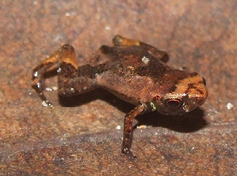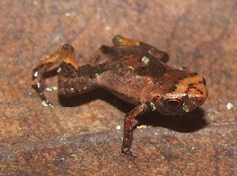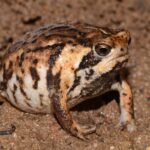Brachycephalus pulex: Discovering Brazil’s Tiny Jewel of the Forest Floor#
In the lush, moisture-rich leaf litter of Brazil’s Atlantic Rainforest, concealed by shaded ferns and sprawling mosses, lives an exquisite wonder of amphibian evolution—a vibrant speck of life known as Brachycephalus pulex. Smaller than a human fingernail, this frog is one of the tiniest vertebrates on Earth, yet its biological, ecological, and evolutionary significance far surpasses its diminutive stature. Despite what their miniature body size may suggest, each individual harbors a wealth of adaptations and behaviors crucial not only to their survival, but to the symphonic biodiversity of their tropical home.
Scientifically intriguing, ecologically significant, and endearingly captivating, Brachycephalus pulex offers us a remarkable window into the resilience and ingenuity of nature. Beyond their dazzling appearance and microscopic dimensions, these frogs highlight the fragility and interconnectedness of forest ecosystems, making their conservation more relevant today than ever before.
Taxonomy and Classification#
Brachycephalus pulex, belonging to the family Brachycephalidae, was described in 2011, making it a relatively recent addition to the scientific narrative of Earth’s biodiversity. Within the genus Brachycephalus, it shares lineage with closely related “pumpkin toads” or diminutive frogs that inhabit isolated mountaintops and forested regions of Brazil. The genus name Brachycephalus translates roughly to “short-headed,” referring to their remarkably reduced cranial proportions and compact skull. The species epithet, pulex, meaning “flea” in Latin, vividly captures this particular species’ extraordinary diminutive size and extraordinary leap—tiny yet exceptionally agile, much like the insect itself.
This frog reliably illustrates a phenomenon called miniaturization. It is an evolutionary adaptation often associated with island habitats or isolated environmental conditions, in this case, forest mountaintops within southeastern Brazil. Miniaturization often leads to unique morphological traits, simplified anatomy, and highly specialized ecological niches, making Brachycephalus pulex and its relatives especially fascinating from an evolutionary biology perspective.
Natural Habitat#
Geographic Distribution#
Brachycephalus pulex thrives exclusively within the delicate confines of Brazil’s Atlantic Rainforest—a globally recognized biodiversity hotspot. Specifically, it is endemic to select areas of montane forests in São Paulo state, inhabiting altitudes generally ranging between 900 to 1000 meters above sea level. These habitats are characterized by steep terrain, cloud-covered peaks, dense vegetation, and particularly humid microclimates—conditions that sustain incredible biological diversity yet remain exceedingly vulnerable to ecological disturbances.
Microhabitat Preferences#
These frogs demonstrate a strong affinity for certain very specific microhabitats. Their presence is usually restricted to leaf litter accumulated on forest floors beneath dense canopies. Within this microhabitat, conditions such as temperature stability, moisture retention, and ample hiding spots make it an ideal refuge. The frogs rely heavily upon this specially preserved microclimate, seeking out moist, dark enclaves between decaying leaves, fallen branches, and soft substrate. Predominantly terrestrial, they rarely venture far from their carefully selected refuge, which serves as both protective haven and hunting ground.
Physical Characteristics#
Few creatures captivate attention as effortlessly as Brachycephalus pulex. At first glance, one might mistake this tiny living jewel for an orange or golden bead nestled inconspicuously among forest floor debris. Adults of this remarkable species measure just about eight millimeters in length—an extraordinary adaptation making them among the world’s smallest tetrapods. Their remarkable size reduction is accompanied by a compact body form, shortened limbs, and simplified digits, reflecting significant evolutionary specializations linked to miniaturization.
The frog’s bold coloration—a vibrant shades of yellow, orange, and occasionally bright red—serves as a stark warning signal in the dense undergrowth. This conspicuousness is not accidental; much like brightly colored insects or poison frogs, the vivid hues act as an aposematic (warning) coloration to predators. Researchers suspect that some Brachycephalus species produce toxic alkaloids concentrated in their skin, deterring predators from considering them as prey. The dazzling pigments contrast sharply with their shadowy surroundings, sending unmistakable signals of danger—a compelling evolutionary strategy perfected through generations.
Behavior and Life Cycle#
Diet and Hunting Strategies#
The everyday life of Brachycephalus pulex revolves around the intricate worlds hidden within the leaf litter. Their small size influences dietary choices, limiting options primarily to microscopic arthropods like springtails (Collembola), mites, and tiny ants. Though minute, they strategically ambush or forage these minuscule creatures, relying on keen eyesight and acute senses responding to extremely subtle movements among leaf debris. Their hunting strategies are efficient, calculated, and profoundly adapted to micro-scale living conditions, exemplifying how evolutionary pressures shape even the smallest behaviors.
Mating and Reproduction#
Mating in the dense forest understory is a lively yet delicate choreography. Male Brachycephalus pulex, barely visible amidst the foliage, stake out small territories and issue quiet, insect-like calls to attract females. These subtle vocalizations are designed not to carry long distances, but to resonate clearly within the small scale of their intimate, concentrated habitats. Females, drawn by carefully orchestrated courtship displays, skillfully locate potential mates within dense litter layers.
Unlike many frogs, this species demonstrates direct developmental modes. Instead of traditional tadpole stages in water, female B. pulex deposit tiny eggs amid damp leaf litter, carefully camouflaged and sheltered from predators and drying conditions. Embryos develop entirely within these terrestrial eggs, emerging fully formed as tiny froglets. Direct development provides an adaptive advantage to this species—offering independence from standing water and reducing predation associated with aquatic stages. Thus, the leaf-litter world to Brachycephalus pulex is nursery, refuge, and home simultaneously.
Ecological Role#
Within their specialized habitats, Brachycephalus pulex frogs play essential roles as both predator and prey within the complex trophic webs of the rainforest floor. By controlling populations of small arthropods, these frogs help regulate decomposition processes, nutrient cycling, and microbial communities pivotal to rainforest ecosystem functions.
Additionally, they occupy a unique ecological niche, acting as bioindicators sensitive to minute changes within their fragile habitat. Through their remarkable sensitivity to environmental shifts—whether air quality, moisture levels, or temperature—scientists regard Brachycephalus pulex as invaluable “early warning systems,” crucial for detecting subtle ecological disturbances early on.
Threats and Conservation Status#
Despite their fascinating adaptations, these miniature frogs face growing threats. Habitat destruction, particularly from human encroachment, agricultural expansion, urbanization, and logging in Brazil’s Atlantic Rainforest, is rapidly fragmenting once-contiguous habitats. Climate change exacerbating droughts, altering rainfall patterns, and shifting temperatures threaten their microhabitats, potentially shrinking available refuge areas critical for their survival.
As relatively recent scientific discoveries, comprehensive data on population trends remain sparse, and as such, Brachycephalus pulex is currently listed as Data Deficient (DD) by the International Union for Conservation of Nature (IUCN). Nevertheless, conservationists and biologists recognize urgent needs to protect these vulnerable creatures through robust habitat protection initiatives and research-driven conservation strategies.
Cultural and Scientific Significance#
Besides holding a unique position within ecological and evolutionary biology spheres, Brachycephalus pulex resonates culturally and scientifically as symbols of biodiversity in Brazil. Their vibrant appearance and incredibly specialized existence have sparked scientific curiosity around evolutionary biology, specialization, and toxin biosynthesis processes. Research into their unique toxins could provide valuable insights into new medicinal or biochemical frontiers.
Conclusion#
In a world defined by grandeur, perhaps the most profound revelations come from the smallest wonders—such as the mesmerizing Brachycephalus pulex. As we strive to grasp the complexity and wonder of the planet’s biodiversity, this diminutive frog reminds us powerfully of the fascinating adaptability, vulnerability, and interconnectivity inherent in nature’s web. Conserving Brachycephalus pulex means safeguarding their rich forest home, securing biodiversity for generations yet unborn.
We must embrace a future of conscientious stewardship, informed curiosity, and deep ecological empathy. Simply put, caring for the Brachycephalus pulex is a celebration of nature in all its magnificent detail.















